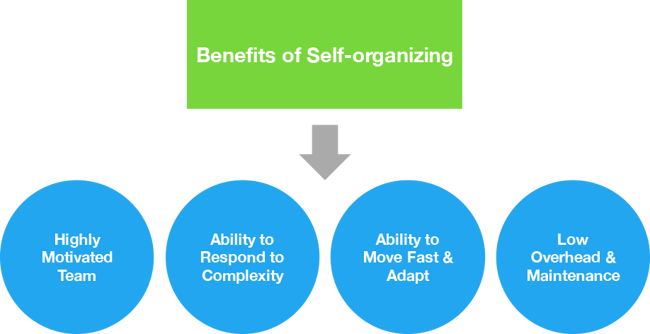When to Use Self-organizing Teams?
Utilizing the full potential of one’s underlings isn’t always the easiest of tasks. It is easy to question the impact an individual employee may have on the company. This has been seen after the industrial revolution as a reserved approach to handing out responsibility. By this, I mean giving workers very specific tasks to focus on and to master throughout repetition.
Although this has been one of the fundamental keys in decrypting the world of mass manufacturing, it can be an inhibiting structure in fields where the challenges faced are complex, as opposed to just plain complicated‚ and require adapting to an ever changing environment.
When doing specific tasks, keeping things simple is most likely the best course of action. Like when building something consisting of parts, identical to each unit. In this, giving every worker creative freedom could cause more harm than good. The outcome would be an increase in the time required to churn out the same amount of products with also a higher risk for defective units.
However, the most efficient way isn’t always the most effective one. This phenomenon can be seen in many a company that's grown so large that the benefits offered by the stability and predictability of layered hierarchy are being outweighed by the inability to react and adapt to our ever changing operating environment.
Breaking free from this classic model and unlocking all that your workers could offer has become a very relevant topic for thousands of organizations. We believe one part of solution to be the use of self-organizing teams.
The somewhat abstract term does not refer to what we’ve all experienced in grade school: a group of students gathering up to complete an assignment, knowing their collaboration will end when it’s over.
No, we’re talking about a dedicated group of like-minded individuals, passionate about a common goal. Individuals who share an understanding of how the strategic goals of the company are linked to the goals, and thus, operations of their own team. An equal and meritocratic setting where participants aren’t afraid to voice their opinion.
To better understand the concept of self-organization, we must first take a closer look at the fundamental structure of a team.
Strategic distribution of authority
Imagine you have a task at hand and you were responsible for putting together a team to complete the said task. Naturally, one often jumps to the classic model where an almost military style hierarchy is implemented based on experience and recommendations. Although this is often a good choice, at least on paper, the unequal distribution of authority makes the “underlings” disengaged as they feel as though their input doesn’t matter as much. It is human nature to desire the feeling of doing something with someone rather than for someone.
By making a team self-organized, you're in practice making every team member an “owner” of the project. This gives a greater sense of purpose to each individual and thus creates a more motivated and committed work environment.
Freedom to balance responsibility
Basically, team structures can be split into four main categories:
- Manager-led teams:
A member of the team is chosen by management to lead the team with full authority. - Self-managing teams:
The team has autonomy over the work process and distribution of responsibility, but the team and its context is compiled by management. - Self-organizing teams:
The overall direction of the team is chosen by management but the team can choose how they want to get there. - Self-governing teams:
The team has full autonomy over its direction and work distribution.
As Steve Denning says in his article about the performance of different team types, sharing most of the team’s responsibilities with the team itself instead of management yields far better results.
Although having this freedom appears to be the key to the purest source of motivation, the team direction should come from management. Self-governing teams appear to have too much dispute over the sense of direction and thus aren’t as efficient or effective The result of Mr Denning’s research indicates that the most high-performing teams are likely to be self-organizing teams.
“Interestingly, my research encountered no examples of self-governing teams in big firms in a high-performance modem apparently because the struggle to decide what to do gets in the way of actually doing it.”
– Steve Denning
So, how does it work in practice?
A poster child for cross-functional organizations consisting of self-organizing teams is none other than Google. What separates Google from many of its competitors is not just the tremendous growth and market share they’ve been able to achieve. It is how, despite this growth, the levels of innovation and creativity have been left relatively unscathed. They’ve realized that the best way for creative problem solving, and outside the box innovation is to prevent the formation of functional silos, thus allowing teams direction over their own work.
An example of Google’s prowess in this field is Gmail. What started out as a one-man project to create an internal filing cabinet for Google, turned out to be a huge success story.
Gmail was an early form of self-organization called a skunkworks project. Paul Buchheit, the creator of Gmail, had begun working on the project during his 20% time. This is something Google provided all of its engineers to increase innovative pastime projects.
Paul kept working on the concept almost every day. After it began to take off, he assembled a team that had the freedom to design and shape their product free of conventional organizational measures and constant micromanaging. Focusing on a single goal of building the the most usable email service led to a service which now has over a billion active users worldwide.
Not limited to technology companies
Another concrete example of finely tuned self-organization is Buurtzorg in the Netherlands, which illustrates how an independent, holistic team approach can be integrated into a wide range of different fields and isn't just applicable for tech companies. In their model of home care nursing, the employees (nurses with different levels of training) form teams of 10-12 individuals to show constant care for 50-60 patients.
How does this differ from any other elderly care service?
Here’s the amazing part: they do their tasks, managed only by their own moral guidelines. The nurses have full freedom and responsibility for a specified group of patients and their care. They even get to hire their own team members. To someone in a managing position, this may seem like a risky entropic endeavor, but it truly isn’t. It is cost-effective and has shown to yield amazing results in patient and employee satisfaction.
It appears that also in this case the freedom of one’s actions begets legitimate care for one’s work.
Final thoughts
Through statistics and positive examples, we can conclude that the worth of a self-organizing team should not be underestimated or undervalued. Fully utilizing your team’s potential is not about giving every worker blind autonomy. It’s about making sure everyone understands the end goal, then trusting the team to find an effective way to get there with the support and resources you can provide.
The applicability of self-organization to a business is quite case-sensitive. It might not be the best approach in straight-forward operations that can easily be broken down into specific tasks. Even some seemingly complicated operations like car manufacturing can fall into this category.
However, when the business is complex, meaning that there are a lot of virtually uncontrollable variables affecting the work and requires the ability to quickly react and adapt to changes in the operating environment it quickly becomes impossible for management to plan the best of course of action and then divide the work into smaller, easy to understand chunks beforehand This is actually the case for most business today with the rise of the service economy and information technology.
A hybrid structure consisting of both layered hierarchy and cross-functional teams, can increase your effectiveness significantly if you can figure out the parts of your organization that can most benefit from this kind of an approach to keep up with the operating environments that are changing faster than ever before.
A self-organizing team also reflects today’s values of transparency, commitment, and agility so implementing it may be just the right course of action to improve not just your effectiveness but also team morale, and thus results.
Interested in Innovation and Leadership?
Join thousands of other innovators and get the latest stories on innovation, leadership and culture straight to your inbox, once a month.







